Pros
Cons
Introduction
Front
{{section_header}}{{section.name}}{{/section_header}}
The Sony KDL-55EX720 is a mammoth, and if you're going to take advantage of that 55-inch screen make sure you have enough room between the TV and the seating area. It's an attractive design, overall, with the elegance that we've come to expect from Sony. The bezel and stand are understated, receding into the background so as to not detract from what's on the screen. In the lower corner of the bezel you'll find the IR receiver, an ambient light & motion sensor, and the IR emitter that send the sync signal to the 3D glasses.

Back
{{section_header}}{{section.name}}{{/section_header}}
The back of the Sony KDL-55EX720, predictably, is mostly unadorned. In the corner is the jack pack of ports. Fortunately, the TV panel can swivel on its base, making the ports more accessible.

Sides
{{section_header}}{{section.name}}{{/section_header}}
For a 55-inch TV, the panel is incredibly thin. That's the real benefit of LED edge-lighting (because uniformity sure isn't a benefit). The panel is so thin that there's no room for control buttons or ports. The ports called out in the photo below are really on the back, but they face the side. The control buttons wrap around the side to the back.

Stand/Mount
{{section_header}}{{section.name}}{{/section_header}}
The Sony KDL-55EX720 has a large, flat, rectangular stand. It's nicely staid and simple, in keeping with the rest of the design. The TV panel can freely swivel about 20-30 degrees in either direction.

Controls
{{section_header}}{{section.name}}{{/section_header}}
The Sony KDL-55EX720's are a series of buttons that wrap around from the side to the back, making them both accessible and discreet.
Remote Control
{{section_header}}{{section.name}}{{/section_header}}
The remote control that ships with the Sony KDL-55EX720 is a variant on the remotes from last year's high-end Bravias, with some small but noticeable exceptions. First, there are prominently placed buttons labeled "Netflix" and "Qriocity" near the top. We're not sure how much Sony had to pay for the use of the Netflix name, but it clearly shows how they perceive Netflix's importance to the marketplace. (We think they guessed right).
The remote is comfortable in your hand, but we still think the volume and channel up/down buttons are too small. Also, there's a big power on/off button on the back of the remote that can be accidentally brushed too easily.

In the Box
{{section_header}}{{section.name}}{{/section_header}}
The Sony KDL-55EX720 ships with a stand & screws, remote controls & batteries, along with some assorted documentation and a very basic guide to get you started. There's no traditional, fat printed instruction manual.
Black Level
{{section_header}}{{section.name}}{{/section_header}}
The Sony KDL-55EX720 managed a great performance in our black level test. As you can see in the chart below, it scored the same as last year's Sony 55NX810 and better than the Samsung C7100, another LCD model. The Panasonic TC-P50VT20, a plasma TV, understandably produced a much deeper black level. More on how we test black level.
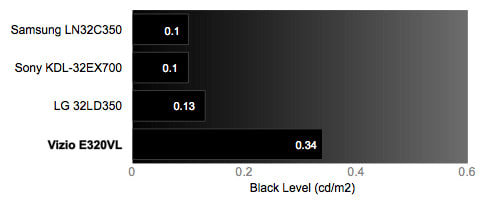
Peak Brightness
{{section_header}}{{section.name}}{{/section_header}}
The Sony KDL-55EX720 is plenty bright. Sure, it's not quite as bright as the Samsung UN46C7100, but anything over 250 cd/m2 or so is bright enough to see in a sunny room. The only problem child here was the Panasonic TC-P50VT20, which failed to deliver a bright enough picture. This proved especially problematic when we switched it over to 3D mode and put on the tinted 3D glasses. More on how we test peak brightness.
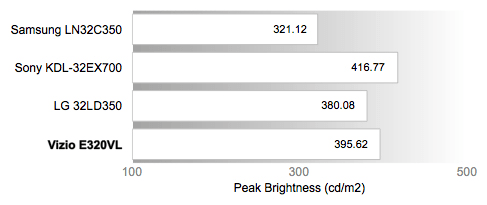
Contrast
{{section_header}}{{section.name}}{{/section_header}}
Sony KDL-55EX720 offers an outstanding contrast ratio of 5376:1, easily beating the Sony NX810 from last year, as well as the Samsung C7100, another strong performer. Sure, Sony described the TV as having "infinite" contrast ratio (utter nonsense), but we're as impressed with this performance as if it had been infinite. More on how we test contrast.

Tunnel Contrast
{{section_header}}{{section.name}}{{/section_header}}
The Sony KDL-55EX720 had little trouble maintaining a consistent black level. Most LCD TVs do not. More on how we test tunnel contrast.
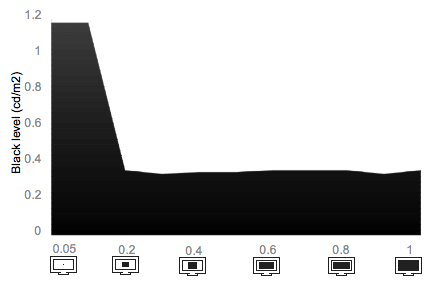
White Falloff
{{section_header}}{{section.name}}{{/section_header}}
The Sony KDL-55EX720 also had no problem producing consistent peak brightnesses. Typically, only plasmas have a hard time in this test. An LCD TV like the Sony EX720 will perform just fine. More on how we test white falloff.
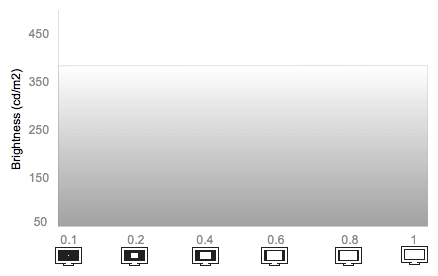
Uniformity
Greyscale Gamma
{{section_header}}{{section.name}}{{/section_header}}
The greyscale gamma test examines how a TV transitions from black to white along the grey scale. The chart below contains a lot of detail, if you know how to read it. First, we're looking at the smoothness of the curve. There are some small hiccups in the lower left, indicating the shadow details. You can expect this to translate into some loss of detail in the shadows – dark greys may all appear the same shade for a certain span of the signal range. As we move up and right, however, the midtones and highlights look great.
There's also the slope of the curve to consider. An ideal slope is between 2.1 and 2.2. The Sony KDL-55EX720's greyscale had a slope of 2.62, which was steeper than we want. Overall, though, we liked the performance a great deal. More on how we test greyscale gamma.
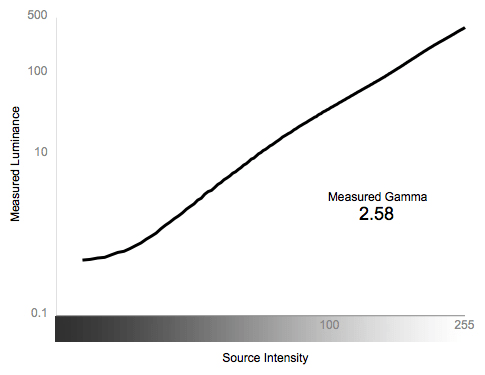
Color Temperature
{{section_header}}{{section.name}}{{/section_header}}
The Sony KDL-55EX720 did an outstanding job maintaining a consistent color temperature. Look at the chart below. We tested the color temperature at every step of the input range and it hardly wavered. Good job, Sony engineers. More on how we test color temperature.

RGB Curves
{{section_header}}{{section.name}}{{/section_header}}
The Sony KDL-55EX720 performed quite well in our RGB color curves test. The transitions in each channel were smooth, and the channels moved in a uniform fashion. The blue channel seemed to have a a few more bumps in the line, which indicates that you might see some color banding. Overall, though, we're impressed that a TV can have such a good color performance as well as great contrast. Too often, we've had to choose between the two. More on how we test RGB curves.

The strips below are digital recreations of the RGB color data test, to give you a sense of what the response curve for each channel looks like. You can see it here compared to three similar TVs and an ideal response curve.
Motion Performance
{{section_header}}{{section.name}}{{/section_header}}
The Sony KDL-55EX720 did very well in our motion tests. Like last year's high-end Sony TVs, the EX720s have a feature called MotionFlow that drastically improves motion smoothness and detail loss. There's a big caveat, though. When MotionFlow is enabled, any film-based content takes on a distinctly odd, video-like look. It works by inserting extras frames, derived by an interpolation process. If you're watching sports, MotionFlow is fine, perhaps even helpful. However, it makes watching movies impossibly strange, and you're much better off disabling the feature. We have to say, though, that it seems to be less heavy-handed than last year's iteration. Perhaps Sony tweaked the algorithm. More on how we test motion performance.
3:2 Pulldown & 24fps
{{section_header}}{{section.name}}{{/section_header}}
The Sony KDL-55EX720 had few problems with native 24fps content, the frame rate that most Blu-Ray movies are in. Be sure to put the CineMotion mode in Auto 2 in order to get the best performance. In our tests, we noted some problems with high contrast, high frequency patterns, as well as the ability to smoothly render low camera pans. More on how we test 3:2 pulldown and 24fps.
Resolution Scaling
{{section_header}}{{section.name}}{{/section_header}}
The Sony KDL-55EX720 has a native 1080p (1920 x 1080) resolution, but much of the content you'll be feeding it will be of a lower resolution. It's up to the TV's internal processing to take those resolutions and rescale them to fit the screen. The Sony KDL-55EX720 is a far from perfect at this task. Let's take each test in turn. More on how we test resolution scaling.
480p
The 480p content lost a lot of screen area due to overscan – 2% on each side and 3% on the top and the bottom.
720p
The 720p content lost 2% on every side to overscan. It also had a lot of problems with high contrast, high frequency patterns, which created unfortunately distracting Moires.
1080i
When we looked at 1080i content, there was no overscan loss, but the TV had some minor problems with Moires in high contrast, high frequency patterns.
3D Effect & Experience
{{section_header}}{{section.name}}{{/section_header}}
All the manufacturers, including Sony, promised better 3D performance with less crosstalk for 2011. We're still not convinced. The crosstalk may be slightly lessened, and the glasses are certainly more comfortable, but watching 3D TV is still far from enjoyable. The active shutter glasses are still substantially larger than passive glasses, and the 3D effect breaks down often enough that you have a hard time immersing yourself. Could you watch a feature film through a zoetrope and have the same carefree, unobtrusive experience as in a movie theater? No, no you could not.
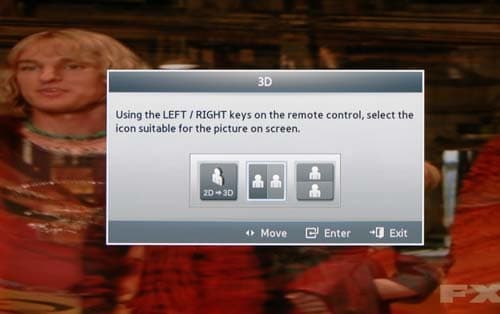
Some of the options in the 3D menu
3D Black & White
{{section_header}}{{section.name}}{{/section_header}}
The Sony KDL-55EX720 loses a huge amount of brightness and contrast ratio, as you can see in the chart below. It's should come as no surprise that when you put on giant tinted glasses and watch TV, you're going to severely cut down on the screen brightness.

3D Color
{{section_header}}{{section.name}}{{/section_header}}
When you put a TV in 3D mode, the colors are processed differently to compensate for the way colors are thrown by the tint in the 3D glasses. Overall, our tests indicate that Sony did a pretty good job. The biggest problem seemed to be producing an accurate white, and then maintaining the color temperature of that white.
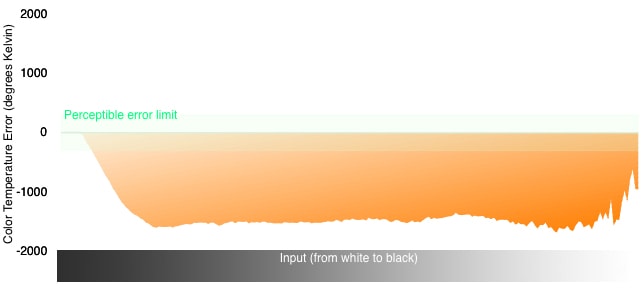
As with all the 3D Sonys we tested last year, the blue channel is most affected in 3D mode, showing a lot less detail. There's also a general lack of shadow detail.
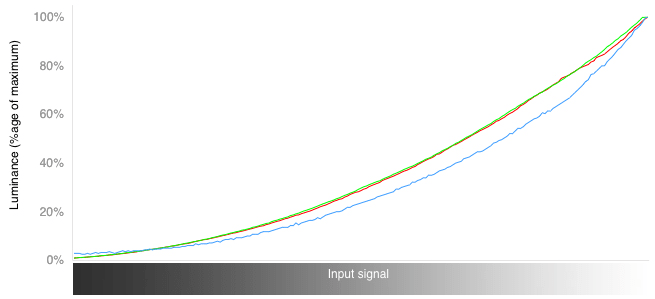
The color gamut matched up fairly well to its 2D performance. The red and blue points lost saturation, and the white point was quite a bit off the mark. Overall, though, it wasn't bad.
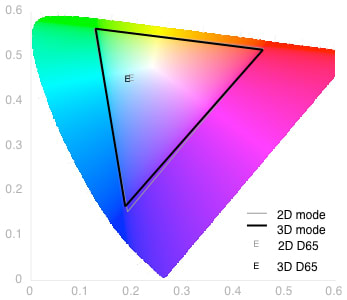
3D Crosstalk
{{section_header}}{{section.name}}{{/section_header}}
Crosstalk occurs when an image intended for one eye bleeds into the other eye. Most frequently, it might appear as a shadow or halo, especially visible in high contrast areas. By and large, it's the biggest problem in breaking down the 3D effect. By the numbers, there was definitely less crosstalk than last year's Sony KDL-NX810. There are still plenty of problems, though. Certain colors do very poorly when set on top of other colors. Black on white, for instance, created a total breakdown of the 3D effect. In fact, black objects on any color background were problematic. White on red and white on blue also caused some problems, but not as bad. In summary, the 3D effect breaks down regularly enough to be annoying and cause headaches. But it's better than last year.
3D Glasses
{{section_header}}{{section.name}}{{/section_header}}
The glasses do not ship with the Sony EX720 series. You'll need to buy them separately for the slightly nauseating price of about $150 per pair. Fortunately, they've been redesigned since last year, and the weight distribution and weight seems more comfortable.
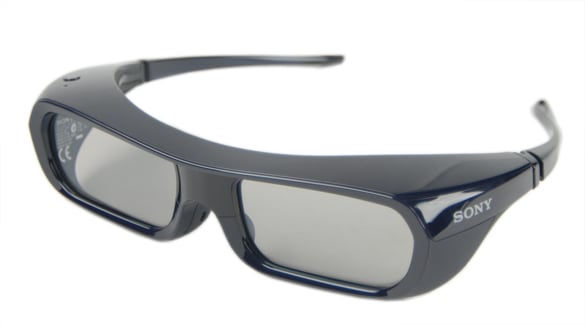
Yes, you will look like a dork with these on
Formats
{{section_header}}{{section.name}}{{/section_header}}
The Sony KDL-55EX720 has a native 1080p resolution, and supports all standard NTSC formats.
Viewing Angle
{{section_header}}{{section.name}}{{/section_header}}
The Sony KDL-55EX720 has an average viewing angle for an LCD TV, measuring about 42 degrees wide (23 degrees from center in either direction). Anyone sitting at a wider angle than that will be missing a lot of the contrast ratio. If you need a TV to serve a particularly wide room, get a plasma.

Reflectance
{{section_header}}{{section.name}}{{/section_header}}
We found the Sony KDL-55EX720 to have a highly reflective screen, especially visible when the TV is displaying dark or large swaths of a uniform color. We can see that it's trying to perform some light dispersion or deflection, because when we shine a light at the screen, it creates a rainbow-colored starburst pattern.
Video Processing
{{section_header}}{{section.name}}{{/section_header}}
The Sony KDL-55EX720 has a bevy of special processing features.
Calibration
{{section_header}}{{section.name}}{{/section_header}}
Our review process starts with a calibration. Using DisplayMate calibration software and a spectrophotometer, we adjust the basic video settings until the picture is optimal. Below, you can see what we decided were the best settings for most situations.
The Sony KDL-55EX720 is particularly confusing because there are three Picture modes, then a completely separate menu full of "scene modes," almost like what you'd find on a digital camera. Scene modes are useful for those that want a quick, one-touch adjustment to picture quality, but don't lend themselves to thorough calibration because they grey-out many of the menu options. In this case, we also found that all but one of the Scene modes – Graphics mode – caused the picture to overscan. So we used Graphics mode and calibrated from there. And in that mode, the TV produced outstanding scores in most of our tests. However, when we checked back the next day, none of the modes were creating overscan. It's one of life's stupid little mysteries.

All of our calibration is done in conjunction with the DisplayMate software.
](http://www.displaymate.com/)
Video Modes
{{section_header}}{{section.name}}{{/section_header}}
Here's a detailed look at the Picture modes (Custom, Standard, and Vivid) and Scene modes (all the rest) that we talked about in the previous section.
The Scene selection listings are located in an entirely different menu, called Preferences, that you may never even find. Thanks, Sony.
Connectivity
{{section_header}}{{section.name}}{{/section_header}}
The Sony KDL-55EX720 is definitely a TV on the cutting edge of home theater features. As such, it has a lot of ports for newer devices, and few ports for older legacy devices. There are 4 HDMIs and a digital audio out, but only one composite and one component input. You'd better upgrade those peripherals if you want to keep up. Additional AV ports include one VGA input and an analog audio output.

There are also plenty of multimedia ports: an ethernet port, optional WiFi (with separate purchase of a USB dongle), and two USB ports. The USB ports can be used to play media from storage devices like a thumb drive or Sony-banded camera. To learn more about this feature, jump to Multimedia and Internet page.
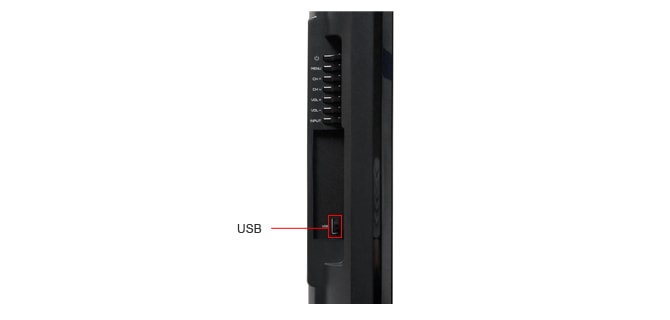
Placement
{{section_header}}{{section.name}}{{/section_header}}
The ports on the KDL-55EX720 are clustered in its back right corner and in a recessed panel on the side. The types of ports are all well-labeled and numbered. Additionally, a swivel stand makes reaching the back easy, despite the gargantuan nature of this LCD screen.
Audio Quality
{{section_header}}{{section.name}}{{/section_header}}
The audio quality of the Sony KDL-55EX720 is rather good, for a TV. There's an obvious lack of bass response compared to a system with a subwoofer, but it didn't sound as muddy as a lot of cheaper TVs we've reviewed. The midtones, high notes, and vocals all came through clean and clear.
There's only a handful of settings in the menu to tweak the audio. You'll find four preset modes: Standard, Dynamic, Clear Voice, and Custom. Sony neglected to include an equalizer, so you're left with just the bass and treble controls. Of course, there's a surround sound emulator, along with some other surround sound emulator called S-Force Front Surround 3D that's supposed to be... even more surround-y??? We're not sure. No matter what you do, two speakers don't sound like five speakers and s subwoofer. Deal with it.
Menu Interface
{{section_header}}{{section.name}}{{/section_header}}
Sony has drastically redesigned the menu for 2011. We're not sure if it's in every model, or just high-end models like the Sony KDL-55EX720. Gone is the excellent XrossMediaBar from last year, which we loved. The new menu system is a mess. There are way too many submenus, and the look and feel is constantly changing. It's almost as if they took the negative reactions from their Sony Google TV and said "Yes! More of this!"
When you hit the Menu button, you'll see a screen like the photo above. It's a split-screen arrangement, with the eight submenus grouped along the bottom, and each submenu's options popping up on the right. This is an efficient use of space, and should have been the template for every part of the menu.

It's not, though. In fact, there are at least two other menu interfaces. If you select the Picture and Display settings, you get the screen above. Perfect. We want to change the picture quality, so now the menu obscures half the screen. Well done, Sony.
Then there's this third menu interface that you only see if you hit the "Options" button on the remote. Now about 1/3 of the screen is obscured. In the Options menu, you have access to some of the picture quality controls, some of the 3D controls, and a bunch of other options that you can only find here.
Overall, the organizational structure is extremely confusing, the interface constantly changes, and it's even difficult to do something as simple as exit the menu (which requires at least three button presses).

Instruction Manual
{{section_header}}{{section.name}}{{/section_header}}
The TV uses an electronic manual called an "i-Manual" that's stored on the TV. You can also find the i-Manual online. It's terrible. Terrible. Sony created a TV with hundreds of features and tools, then neglected to build a digital manual that doesn't allow you to do a simple keyword search. Really, Sony? Even a simple PDF allows for that. Apparently, a PDF didn't allow them the rich, interactive, and aggravating experience they were trying to create.
Instead, you have to use the table of contents to answer your questions, which requires you to first know the section in which your answers lie. It took us five minutes of searching to determine if the TV can accept mice and keyboards to browse the internet (it can't). You can find the Sony KDL-55EX720's i-Manual here.

A manual for so many TV models, they have to be further categorized by type.
Internet Features
{{section_header}}{{section.name}}{{/section_header}}
The Sony KDL-55EX720 has a boatload of streaming content and internet services, even better than last year's already-great selection. They've added buttons on the the remote control for instant access to Netflix and Qriocity,Sony's burgeoning new movie and music service. But Sony's apparent inability to create an elegant interface prevents you from knowing, or even wanting to know about them. (Read previous page for our complaints about the menu.)
The streaming content features are broken up into a jumble of submenus. Qriocity gets top billing with its only little menu icon. The rest of the items are stashed in the "Internet Content" submenu seen below.
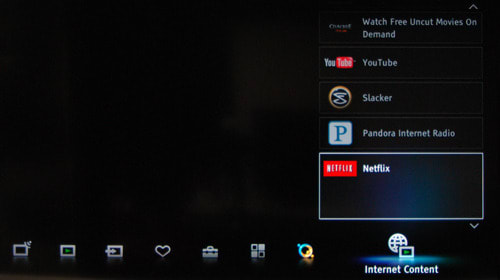
Some of the more well-known services like Netflix, Pandora, and YouTube get special billing, but Sony hides dozens more in the "Bravia Internet Video" sub-submenu. By and large, most of these deserve to be hidden, as they're hobby-oriented services like videos for cooking, exercise, or style. Others could have been called out for special attention, but didn't. Unfortunately, there's no way to customize the menu for user preferences.
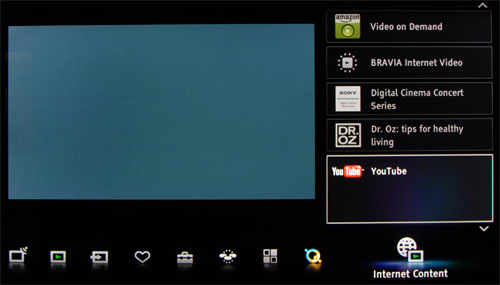
Another cool feature Sony added this year is called TrackID, which either functions like or is Gracenote, a music database service. Essentially, you can be watching TV and when a song comes on that you like but can't recognize, simply hit the TrackID button on the remote, wait about 10-30 seconds, and the track information will appear in the corner of the screen. Simple but amazing, and a perfect addition to a "smart TV."
Last year Sony released the first TV with a built-in, fully functioning internet browser on its Sony Google TV series (read full reviews on the 32-inch and 46-inch versions). We liked the idea, but had a lot of complaints about the interface and innovative but cludgy remote control.
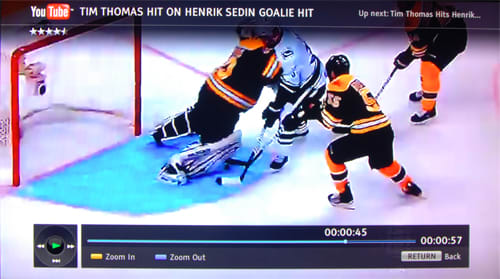
The YouTube playback is a wonderful thing.
Many of the new 2011 Sonys, like the KDL-55EX720, include a browser, a seemingly great feature that is absolutely crippled by a godawful interface. Everything is done through the skinny remote control that comes with the TV. Look at the image below. That hot mess is the method for typing in URLs. To click on a link, you have to use the use the d-pad on the remote to scroll through every click-able item until you get to the one you want. What's worse, Sony does not allow the use of mice or keyboards, despite having two perfectly good USB ports.
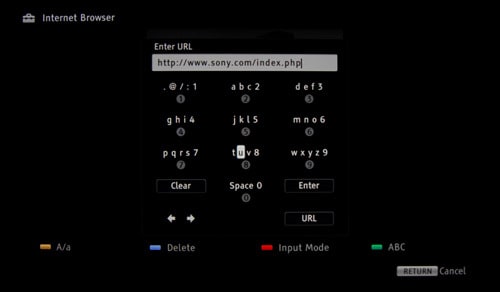
There's simply no way that you could entice us to use this TV as an internet device, unless every computer in the world had been destroyed by some sort of Sony-engineered virus. It's best to consider the KDL-55EX720 as a computer with a lot of streaming video and music, and just forget that the browser is even there.
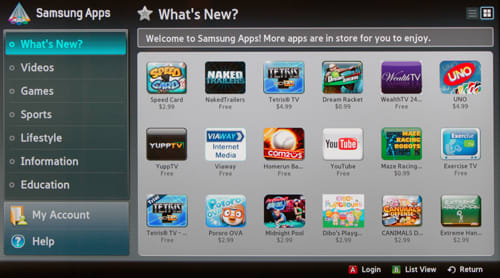
There are also plenty of games to download, free and paid, new and classic
Local Media Playback
{{section_header}}{{section.name}}{{/section_header}}
The Sony KDL-55EX720 can play back a whole variety of still images, audio files, and video files (detailed here in the manual), all through the two USB ports on the side. When you plug in a USB mass storage device (like a thumb drive or certain cameras and camcorders), a little item on the screen should pop up asking you if you'd like to connect. Nearly every TV we've reviewed provides that ease of use. The KDL-55EX720 did not, but we'll assume there's probably an option someone in the menu that enables this.
To get the local media playback going, we had to dig around in the menu and find the submenu with the universal "play" symbol (a triangle pointing forward). There are three options in the menu: Photos, Videos, and Music. Make your choice, then select which device you which to browse in.
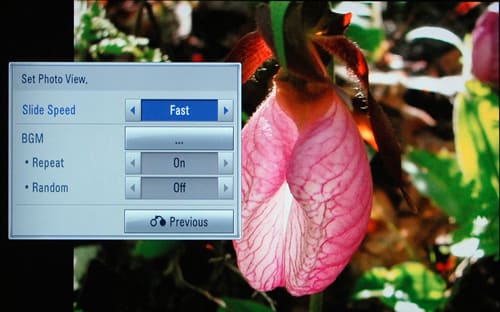
You can create slideshows and playlists with all three types of media. You can also combine photos and music to create multimedia playlists.
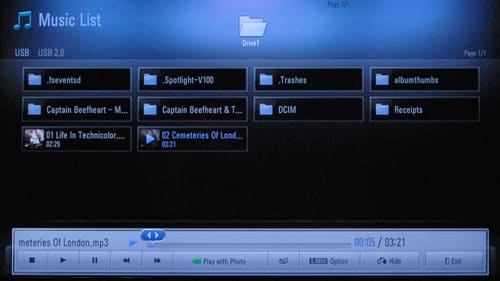
Other Media
{{section_header}}{{section.name}}{{/section_header}}
The Sony KDL-55EX720 does not support any other type of media.
Power Consumption
{{section_header}}{{section.name}}{{/section_header}}
The Sony KDL-55EX720 has made solid strides in power efficiency, thanks mostly to the LED edge-lighting. The TV has a very bright screen, and in order to get the lowest power costs, you'll want to dial the backlight down a little. The chart below has all the details.
As you can see in the comparison chart, the Sony KDL-55EX720 does very well against similarly sized TV from last year. Note in particular how expensive the Sony 55NX810, an LCD, was, nearly as much as the plasma Panasonic.
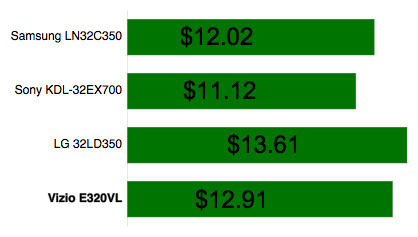
Value Comparison
{{section_header}}{{section.name}}{{/section_header}}
The Sony KDL-55NX810 is a strong television, but considerably more expensive than the newer KDL-55EX720, which has the same screen size and most of the same features. (You can find it cheaper online, to be sure) The NX810's big bonus is the built-in WiFi, while the EX720 requires a separately purchased (both have ethernet ports). Neither include 3D glasses with purchase. We'd probably go with the newer TV, which has a slightly more robust online content system. If you can find a really great deal on the NX810, though, we wouldn't actively turn you away from it.
Blacks & Whites
{{section_header}}{{section.name}}{{/section_header}}
The Sony NX810 produced a great black level, but seemed to have a hard time getting the whites bright enough. The Sony KDL-55EX720 surpassed it by quite a bit, nearly doubling the contrast ratio.

Color Accuracy
{{section_header}}{{section.name}}{{/section_header}}
Both Sonys were very strong color performers. However, the Sony KDL-55EX720 had a more uniform color response.
Motion
{{section_header}}{{section.name}}{{/section_header}}
The Sony KDL-55EX720 produced a slightly smoother motion performance and less artifacting.
Viewing Effects
{{section_header}}{{section.name}}{{/section_header}}
The Sony KDL-55EX720 and Sony 55NX810 performed nearly identically in viewing angle. Neither were impressive and crapped out at about 40 degrees – average for an LCD TV.
Connectivity
{{section_header}}{{section.name}}{{/section_header}}
The Sony KDL-55EX720 have nearly the same selection of ports, but the NX810 series includes built-in WiFi, while the EX720 requires a separately purchased USB dongle.
Other Comparisons
{{section_header}}{{section.name}}{{/section_header}}
The 3D performance of the Sony KDL-55EX720 and Sony NX810 were largely similar. The glasses are more comfortable in the newer EX720, but there's still a fair amount of crosstalk and a big loss in contrast.
Value Comparison
{{section_header}}{{section.name}}{{/section_header}}
The Samsung UN46C7100 is a 46-inch LCD, a smaller screen than the 55-inch Sony KDL-55EX720, but there's a 55-inch version of the Samsung that has all the same specs as what we detail below. The C7100 is slightly more expensive (by MSRP, it's may be cheaper by online), but that price includes two pairs of 3D glasses. The Sony ships with none. We really liked the core performance of the Samsung C7100, but caution that the 3D feature is an expensive add-on that we couldn't justify.
Blacks & Whites
{{section_header}}{{section.name}}{{/section_header}}
The Samsung UN46C7100's black level performance was good, but not as good as the Sony KDL-55EX720. It's peak brightness was even brighter, but the math was not in Samsung's favor and the Sony ended up with the wider contrast ratio.

Color Accuracy
{{section_header}}{{section.name}}{{/section_header}}
Both the Samsung UN46C7100 and the Sony KDL-55EX720 were great color performers. They maintained a consistent color temperature and the color curve responses were even and smooth.
Motion
{{section_header}}{{section.name}}{{/section_header}}
There was no substantive difference between the two TVs in terms of motion performance. They were both quite good.
Viewing Effects
{{section_header}}{{section.name}}{{/section_header}}
The Samsung UNC7100 has a terrible viewing angle, even for an LCD TV.
Connectivity
{{section_header}}{{section.name}}{{/section_header}}
The Samsung C7100 only has a shared set of composite and component ports. The Sony EX720, thankfully, breaks it up into two sets of ports.
Other Comparisons
{{section_header}}{{section.name}}{{/section_header}}
The Samsung C7100's 3D performance showed a lot of crosstalk issues. It ships with two pairs of glasses.
Value Comparison
{{section_header}}{{section.name}}{{/section_header}}
The Panasonic TC-P50VT20 is a 50-inch plasma TV. It offered the best 3D performance of any TV we tested last year, and most publications agreed with us. The TV was far from perfect though, which included a total shutdown of contrast ratio once you put the glasses on. Apart from the 3D performance, the Panasonic is a far less elegant experience than the Sony KDL-55EX720, or even last year's Sonys. The menus are ugly, the online experience is a far cry from Sony's, and the TV set itself is boxy and cheap looking, despite its great performance.
Blacks & Whites
{{section_header}}{{section.name}}{{/section_header}}
The Panasonic TC-P50VT20 was plenty dark when we tested the black level, easily beating even the best LCD models. However, it had a very hard time producing a decent peak brightness. As such, the contrast ratio was rather disappointing. The Sony KDL-55EX720 couldn't match the Panasonic's black level, but a nicely bright screen meant a great contrast ratio. If you plan on watching TV in a brightly lit room, you're definitely better off with the Sony. If the TV is destined for a dark den or movie room, the Panasonic will offer the better looking shadows.

Color Accuracy
{{section_header}}{{section.name}}{{/section_header}}
The Sony KDL-55EX720 outstripped the Panasonic TC-P50VT20 in our color performance tests. It had a more consistent color temperature and much smoother RGB color curves.
Motion
{{section_header}}{{section.name}}{{/section_header}}
The Panasonic TC-P50VT20 showed a slightly superior motion performance.
Viewing Effects
{{section_header}}{{section.name}}{{/section_header}}
The Panasonic P50VT20 is a plasma TV, which is invariably superior to an LCD in viewing angle. Far superior.
Connectivity
{{section_header}}{{section.name}}{{/section_header}}
The Panasonic has far more ports, including more connections for older devices and an SD/SDHC card slot.
Other Comparisons
{{section_header}}{{section.name}}{{/section_header}}
The Panasonic's 3D performance showed a lot less crosstalk than the LCD TVs we reviewed last year, which led us to the same conclusion as most experts last year that plasma screens handle active shutter better.
Conclusion
The Sony KDL-55EX720 ($2399 MSRP) is a high-end TV rich with all the latest features, including 3D display and a boatload of streaming content. We like what's under the hood, as well. It's one of the stronger TVs we've reviewed in terms of core performance. In our testing, we noted great black levels and contrast, an excellent color performance, and smooth motion.
All TVs have their downsides, though, don't they? As with most LED-edgelit LCDs, they had a hard time creating an even illumination across the screen, resulting in hot corners and blotchiness. Sony also revamped the menu system – much to our chagrin. The 2010 Sony menus were the best in the industry, and the redesign only muddies the interface with confusing layouts.
Throughout 2010, we thought that Sony led the pack in streaming content offerings. This year, they've continued the walled garden approach, even as their main competitor, Samsung, is opening up their platform to outside services. But Sony has not stagnated, and is instead choosing to showcase a blue chip partner, Netflix, with a dedicated button on the remote control. There's also a Qriocity button, a rather cheap attempt to put Sony's lackluster streaming content library on the same level as the online movie service that is shifting the tectonic plates of Hollywood.
Overall, the Sony KDL-55EX720 is a great TV, but it's always a wise move to wait until it's been on the shelves for while to the price can fall.
Model Series Comparison
{{section_header}}{{section.name}}{{/section_header}}
The Sony EX720s are a high-end series of televisions, all of which offer 3D display and a huge array of streaming content services. None of the TVs include 3D glasses with purchase.
Photo Gallery
{{photo_gallery "Front Tour Image", "Back Tour Image", "Sides Tour Image", "Stand Photo", "Controls Photo", "Remote Control Photo", "Connectivity Tour Image 1", "Connectivity Tour Image 2", "Connectivity Extra Photo", "Menu Main Photo", "Menu 2 Photo", "Internet Features 1 Photo", "Internet Features 2 Photo", "Internet Features 3 Photo", "Local Media Playback 1 Photo", "Local Media Playback 2 Photo"}}
Ratings & Specs
{{manufacturer_specs_table}}
Meet the tester
David Kender oversees content at Reviewed as the Editor in Chief. He served as managing editor and editor in chief of Reviewed's ancestor, CamcorderInfo.com, helping to grow the company from a tiny staff to one of the most influential online review resources. In his time at Reviewed, David has helped to launch over 100 product categories and written too many articles to count.
Checking our work.
Our team is here to help you buy the best stuff and love what you own. Our writers, editors, and experts obsess over the products we cover to make sure you're confident and satisfied. Have a different opinion about something we recommend? Email us and we'll compare notes.
Shoot us an email